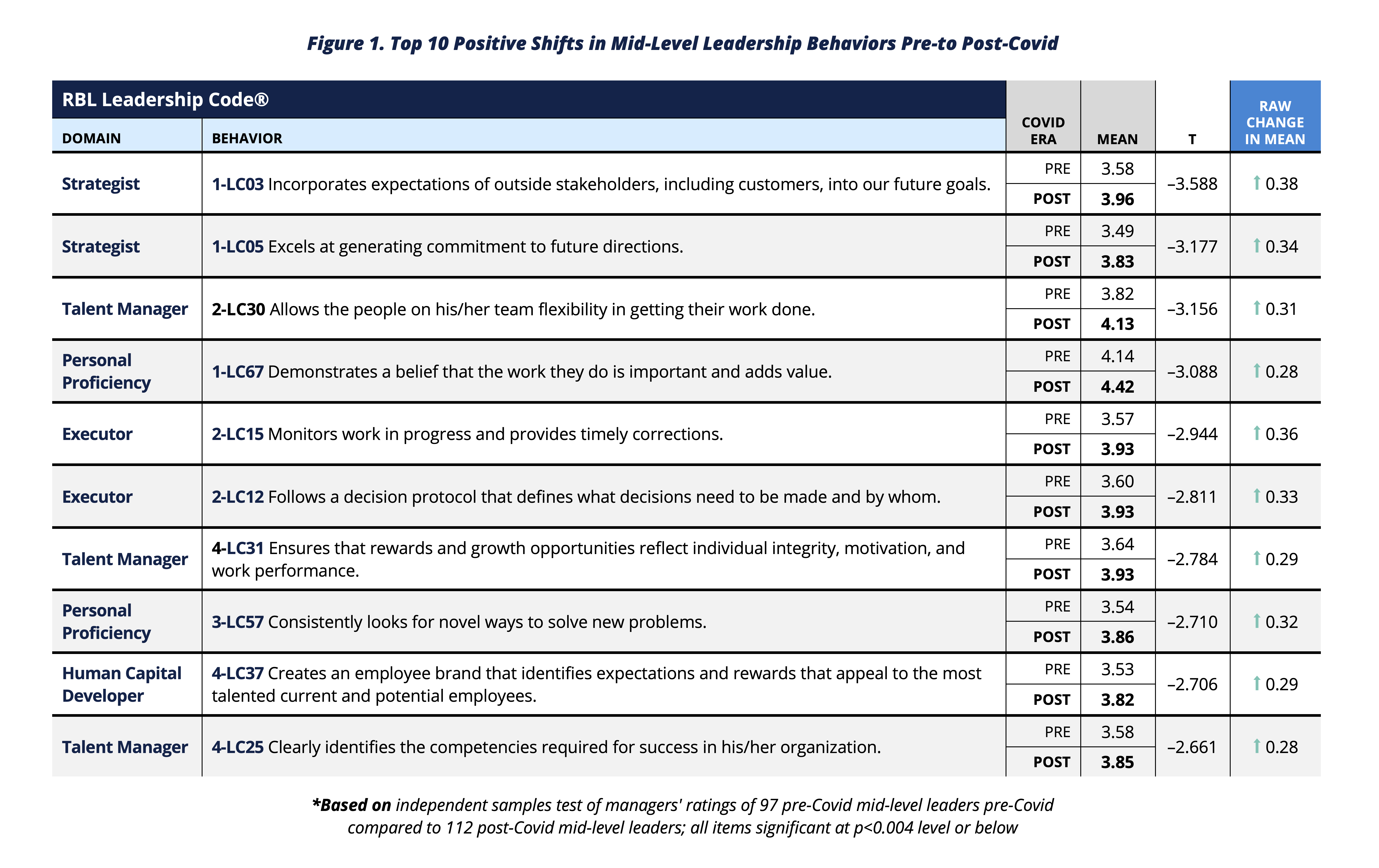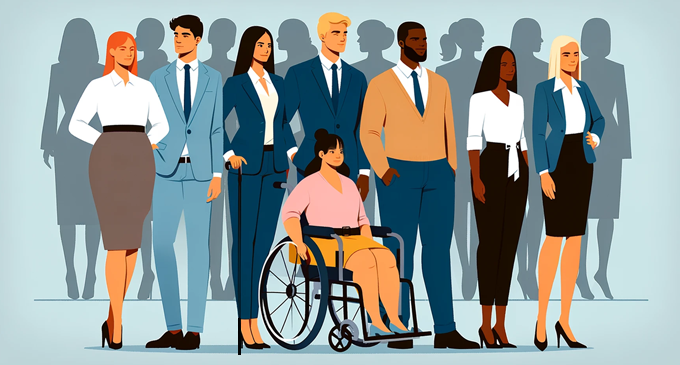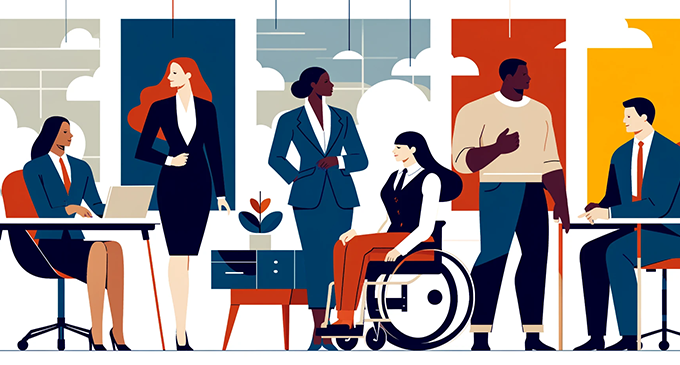The Top 4 Skills Mid-level Leaders Grew During the Pandemic and How to Ensure Your Organization Sustains Them
Key Takeaways:
- Despite pandemic challenges, mid-level leaders showed resilience and adaptability, surpassing expectations with improved performance.
- Post-COVID mid-level leaders demonstrated better anticipation of stakeholder needs and increased agility in response to changing market dynamics.
- They prioritized innovation, inclusivity, and fair rewards, aligning with evolving workforce expectations and organizational needs.

The Top 4 Skills Mid-level Leaders Grew During the Pandemic and How to Ensure Your Organization Sustains Them

Mid-level leaders are the backbone of the organization. They translate organizational strategy into sustainable execution across the organization. Their role is multi-faceted, and the pandemic only added stress, complexity, and chaos to the demands placed on them. We wondered—How did the stressors of the pandemic (with its budget and resource constraints, hiring and training freezes, rapidly changing global environment, and communication challenges, to name a few) impact mid-level leadership?
Going into the data analysis, we anticipated declines in perceived contribution and value for these leaders. In the face of the complex demands and uncertainties of the last four years, they faced the difficult task of inspiring and connecting first-line leaders with a hopeful vision for the future while delivering in very challenging and quickly changing circumstances.
What we found surprised us.
Methodology
To understand how the experiences of leading during COVID impacted mid-level leaders’ strengths, we turned to our longitudinal Leadership Code database which contains over 2.2 million ratings from 2009-2023. We isolated 143,065 ratings of mid-level managers from the periods of 2015-2019 (pre-Covid) and 2021-2023 (post-Covid). Each mid-level leader in the database was evaluated by their manager, peers, and direct reports on 67 leadership behaviors drawn from five research-based leadership domains (Strategist, Executor, Human Capital Developer, Talent Manager, and Personal Proficiency) in the RBL Leadership Code®. We then looked at which behavioral items had the biggest change in ratings for mid-level leaders from pre- to post-COVID.
(While this analysis focuses on where mid-level leaders got stronger, see here for our findings on how leadership requirements have changed for mid-level leaders.)
New Mid-Level Leader Strengths
Instead of declining, we found that mid-level leaders made statistically significant improvements in overall item mean scores across 70 percent of all behaviors, with an overall average 5 percent increase in perceived organizational value contribution.
The ten items listed in Figure 1 have the largest pre- to post-COVID positive change in mean ratings.

Key Improvements
Mid-level leaders have made significant improvements in four key areas that strongly align with organizational capabilities we believe are needed for the organizations of tomorrow.
- Use external awareness to set a future direction that is inspiring and impactful. The biggest skills gain for mid-level leaders from pre- to post-COVID has been an improvement in the ability to anticipate the needs and expectations of external stakeholders and inspire commitment in their organization to delivering on these expectations. The pandemic disrupted the business-as-usual, comparative predictability of how needs and expectations would evolve and required mid-level leaders to focus more on external trends and changing customer needs. They had to help their teams and first-line leaders stay committed and inspired to make the changes necessary to meet these needs, often in radically new or unprecedented ways given global disruptions such as travel restrictions and supply-chain complexities.
- Balance structure and flexibility to create agility. In their book, Reinventing the Organization, Dave Ulrich and Arthur Yeung highlight the new market-oriented capabilities needed for organizations to be agile and responsive in a rapidly changing environment. Our data aligns with what their research predicted and the pandemic demanded: the need for agility everywhere to help organizations deliver on rapidly changing customer expectations. Mid-level leaders made gains through COVID in their ability to both delegate and speed up decision-making while keeping tabs on how things are going closely enough to redirect when needed. They improved in empowering their teams to be more autonomous and flexible in meeting customer needs and getting the work done. More here and here on the leadership agility required to win in today’s economy.
- Look for new ways to solve problems. The data also shows that today’s mid-level leaders have become more innovative over the last four years. The COVID environment demanded an evolution in approaches to leadership, communications, collaboration, ways of working, operational models, strategic thinking, and more. The stretch helped (or perhaps forced) mid-level leaders to be more open to doing things differently. Our data shows that in addition to looking for new ways to solve problems, mid-level leaders improved in being receptive to feedback, understanding their personal strengths and weaknesses, and recovering quickly from setbacks – all characteristic of individual agility and growth mindset.
- Ensure fair and motivating rewards and opportunities. We think this fourth gain speaks to two areas: increased attention to the benefit and impact of inclusion initiatives and shifts in how rising generations of talent connect with the organizations they work for. The demands of the pandemic and its subsequent social upheaval contributed to shifts in ways of working (remote work, new technologies, new employee expectations, for example). We suggest one positive outcome is that mid-level leaders have improved in equitably aligning growth opportunities and rewards to individuals and more clearly articulating a merit-based vision of what is required for success. They are not only better able to align rewards but they are also better able to create and articulate an employee brand that gives confidence for a positive future and appeals to talent.
Reinforcing Gains
The last four years have given mid-level managers the opportunity to raise the bar in key leadership areas characteristic of agile organizations: an aggressive outside-in focus on customers; more agile, autonomous teams; greater innovation; inclusive, outcomes-focused rewards; and passion for the future. These were likely “have to” adjustments for pandemic survival – but will they continue as industries and economies normalize? As one former client said it, “We come together great in an emergency, but will we be able to rally our workforce and do things differently when the ‘building is not burning down?’”
To sustain these agile gains will require intentional focus on the key areas where middle managers collectively shifted. It will require facilitating an understanding of the specific cultural, individual, and social practices that facilitated the improvements and building deliberate strategies to reinforce and maintain them.
We suggest the following to help organizations sustain the learning and skills development that mid-level managers gained:
- Confirm the improvements. The areas listed above are general based on a global dataset and multiple companies. Engage executives, mid-level leaders, and direct reports of mid-level leaders and ask them what changes they saw in mid-level leadership behaviors and practices. Begin with the list above and then ask:
- Did you notice changes in mid-level leaders in these areas?
- What other changes did you notice if you compare their skills and practices today with before the pandemic?
- How important are these changes in how your teams and functions deliver results to stakeholders today?
- Where could we be at risk of reverting to pre-COVID practices?
- Engage executive support. Cultivate strong executive support for mid-level leaders. Even as the data indicate significant key improvements in mid-level leaders’ skills/capabilities characteristic of agile organizations (customer focus, flexibility, empowered decision making, innovation, equitable rewards), our data also shows that their managers’ perspective of what drives organization value did not shift correspondingly. These gains may not be sustained without strong executive support to empower mid-level leaders to continue to drive innovative change forward. Consider the following:
- What would it take to give your mid-level leaders the decision-making rights, resources, and support they need to continue to bring new customer-centric solutions to the table?
- Do our rewards, recognition, and performance evaluation systems reinforce agility?
- Create a culture of learning and improvement. Building a sustainable culture of agility, innovation, and customer responsiveness with empowered, autonomous teams requires ongoing collaboration, clear decision-making, information sharing, and strategic talent development. Although our data suggests that organizations generally have made gains across the areas listed above, as you lean into future-forward planning for your organization’s strategy and culture, make sure you are leveraging the gains. Here are questions for consideration:
- How can you expand organizational sharing/learning?
- Are there practices and improvement gains made in one area of the organization that could be shared or implemented across the organization?
- Where can you be more deliberate in talking about new and critical agile skills gains and reinforcing them in the organization’s leadership expectations and talent practices (promotions, hiring expectations, leadership development, etc.)?
With all of the focus on agility in the last few years, identifying and leveraging growth gains your middle managers have already made is low-hanging fruit in moving toward a more agile culture. Underlining and reinforcing the skills they have gained in using external awareness to inspire future direction, balancing flexibility and structure and building agility, looking for new ways to solve problems, and ensuring fair and motivating rewards are powerful opportunities to make your organization more competitive for the future.
To discuss how this research can help you build an evidence-based leadership brand and culture that increases value for your stakeholders, contact us to be connected with our leadership experts.
For more mid-level leadership research insights, click here and here. For first-line leadership research insights, click here. For executive leadership research insights, click here.


